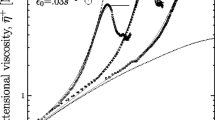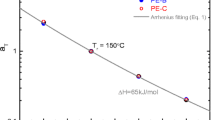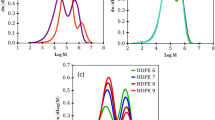Summary
In addition to earlier findings ofMeißner on a low density polyethylene that in the linear range of deformation the time-dependent elongational viscosity is three times the shear viscosity the validity of the relationship\(\mathop D\limits^ \circ (t) = 1/3\mathop J\limits^ \circ (t)\) could be demonstrated where\(\mathop D\limits^ \circ (t)\) and\(\mathop J\limits^ \circ (t)\) describe the compliances in elongation and shear, respectively. In the nonlinear rangeJ(t) was found to increase with stress whereasD(t) decreases. The nonlinear viscosity-time behaviour is different in shear and elongation, too. The shear viscosity obtained by relating the stress to the rate of viscous strain decreases with shear from the zero shear viscosity to its steady-state value. The elongational viscosity goes up with time from 3η 0 to a higher steady-state value.
The temperature dependence which was determined by measuring the steady-state elongational viscosities at different constant stresses as a function of temperature and by shifting the tensile creep compliancesD(t) measured at constant stress with respect to time, was found to be exactly the same as in shear. This result could indirectly be verified by some constant stretching rate tests. It was shown experimentally that the recoverable strain in the steady-state is independent of temperature if measured at constant stress.
Zusammenfassung
In Ergänzung früherer Ergebnisse vonMeißner an einem Polyäthylen niedriger Dichte, die im linearen Bereich der Verformung für die zeitabhängige Dehnviskosität das Dreifache der Scherviskosität ergaben, konnte die Gültigkeit der Beziehung\(\mathop D\limits^ \circ (t) = 1/3\mathop J\limits^ \circ (t)\) gezeigt werden.\(\mathop D\limits^ \circ (t)\) und\(\mathop J\limits^ \circ (t)\) sind die Nachgiebigkeiten in Dehnung und Scherung. Im nichtlinearen Bereich steigtJ(t) mit zunehmender Spannung an, währendD(t) abfällt. Die Zeitabhängigkeit der Viskosität, definiert als der Quotient aus Spannung und Geschwindigkeit des viskosen Deformationsanteils, ist in Scherung und Dehnung ebenfalls unterschiedlich. Die Scherviskosität fällt von dem Wert der Nullviskositätη 0 mit wachsender Scherung auf einen stationären Wert ab, die Dehnviskosität dagegen steigt von 3η 0 auf einen höheren stationären Wert an.
Die Temperaturabhängigkeit wurde aus Messungen des stationären Wertes der Dehnviskosität bei konstantgehaltener Zugspannung und aus einer Verschiebung der bei unterschiedlichen Temperaturen, aber konstanten Spannungen gemessenen Nachgiebigkeiten in bezug auf die Zeit bestimmt. Sie ist dieselbe wie in Scherung. Dieses Ergebnis konnte indirekt durch Messungen mit konstanter Dehngeschwindigkeit bestätigt werden. Die reversible Dehnung im stationären Zustand wurde bei konstanter Zugspannung als von der Temperatur unabhängig gefunden.
Similar content being viewed by others
References
Laun, H. M., H. Münstedt, Rheol. Acta17, 415 (1978).
Meißner, J., Rheol. Acta8, 78 (1969).
Münstedt, H., Rheol. Acta14, 1077 (1975).
Laun, H. M., H. Münstedt, Rheol. Acta15, 517 (1976).
Meißner, J., Pure and Applied Chemistry42, 553 (1975).
Meißner, J., Trans. Soc. Rheol.16, 405 (1972).
Meißner, J., J. Appl. Polym. Sci.16, 2877 (1972).
Meißner, J., Rheol. Acta10, 230 (1971).
Vinogradov, G. V., V. D. Fikham, B. V. Radushkevich, Rheol. Acta11, 286 (1972).
Vinogradov, G. V., B. V. Radushkevich, V. D. Fikham, J. Polym. Sci. A-2,8, 1 (1970).
Laun, H. M., J. Meißner, in preparation.
Meißner, J., Rheol. Acta14, 471 (1975).
Meißner, J., Rheol. Acta14, 201 (1975).
Schwarzl, F., A. J. Staveman, J. Appl. Phys.23, 838 (1952).
Ferry, J. D., Viscoelastic Properties of Polymers, John Wiley and Sons (New York 1970).
Laun, H. M., Rheol. Acta17, 1 (1978).
Wagner, M. H., H. M. Laun, Rheol. Acta17, 138 (1978).
Münstedt, H., submitted to Journal of Rheology.
Author information
Authors and Affiliations
Additional information
With 17 figures
Rights and permissions
About this article
Cite this article
Münstedt, H., Laun, H.M. Elongational behaviour of a low density polyethylene melt. Rheol Acta 18, 492–504 (1979). https://doi.org/10.1007/BF01736955
Received:
Issue Date:
DOI: https://doi.org/10.1007/BF01736955




